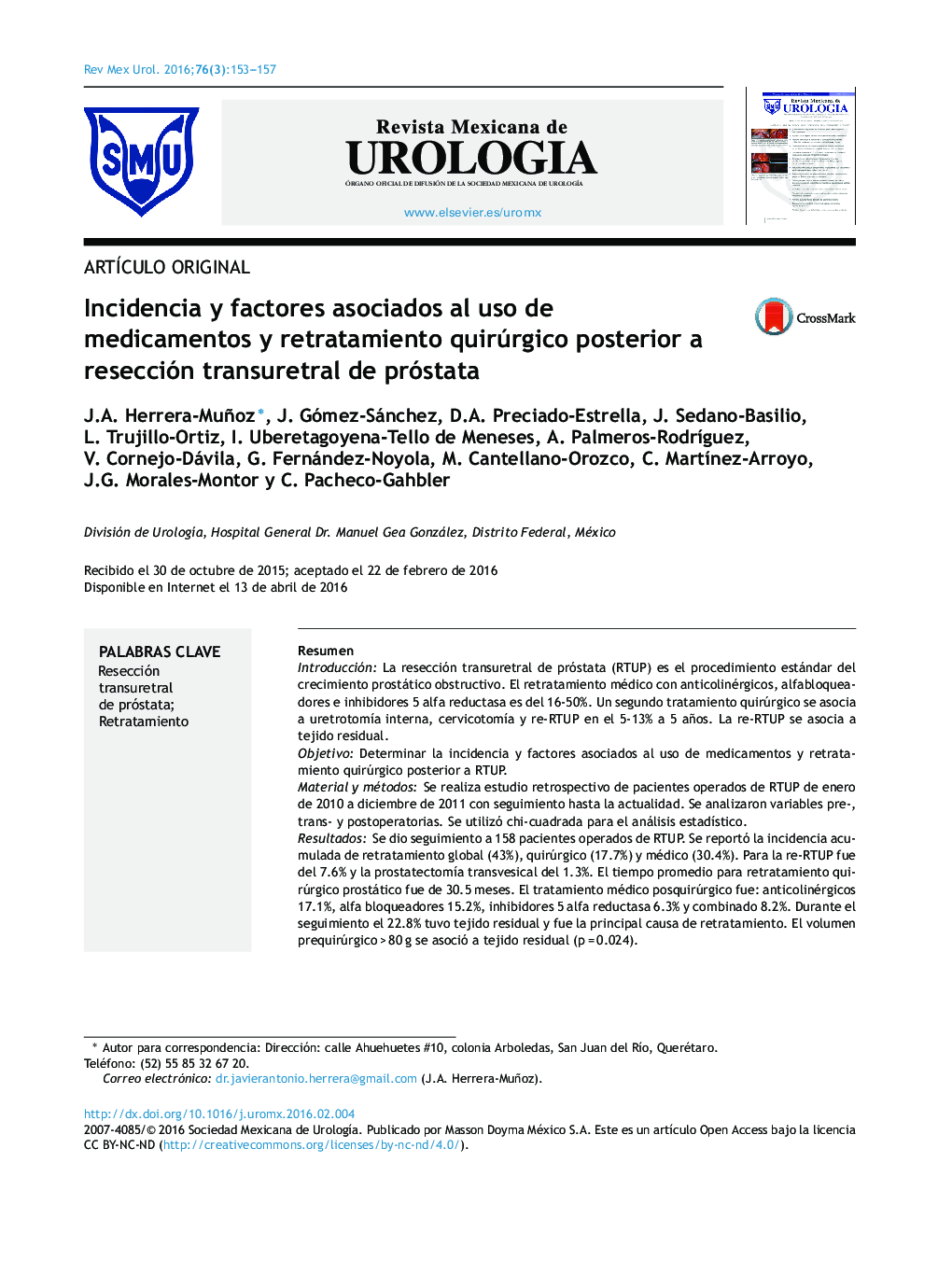| کد مقاله | کد نشریه | سال انتشار | مقاله انگلیسی | نسخه تمام متن |
|---|---|---|---|---|
| 4274247 | 1285250 | 2016 | 5 صفحه PDF | دانلود رایگان |
ResumenIntroducciónLa resección transuretral de próstata (RTUP) es el procedimiento estándar del crecimiento prostático obstructivo. El retratamiento médico con anticolinérgicos, alfabloqueadores e inhibidores 5 alfa reductasa es del 16-50%. Un segundo tratamiento quirúrgico se asocia a uretrotomía interna, cervicotomía y re-RTUP en el 5-13% a 5 años. La re-RTUP se asocia a tejido residual.ObjetivoDeterminar la incidencia y factores asociados al uso de medicamentos y retratamiento quirúrgico posterior a RTUP.Material y métodosSe realiza estudio retrospectivo de pacientes operados de RTUP de enero de 2010 a diciembre de 2011 con seguimiento hasta la actualidad. Se analizaron variables pre-, trans- y postoperatorias. Se utilizó chi-cuadrada para el análisis estadístico.ResultadosSe dio seguimiento a 158 pacientes operados de RTUP. Se reportó la incidencia acumulada de retratamiento global (43%), quirúrgico (17.7%) y médico (30.4%). Para la re-RTUP fue del 7.6% y la prostatectomía transvesical del 1.3%. El tiempo promedio para retratamiento quirúrgico prostático fue de 30.5 meses. El tratamiento médico posquirúrgico fue: anticolinérgicos 17.1%, alfa bloqueadores 15.2%, inhibidores 5 alfa reductasa 6.3% y combinado 8.2%. Durante el seguimiento el 22.8% tuvo tejido residual y fue la principal causa de retratamiento. El volumen prequirúrgico > 80 g se asoció a tejido residual (p = 0.024).ConclusionesLa incidencia de retratamiento quirúrgico es mayor que la de la literatura (17.7% vs. 13%). El tratamiento médico es menor del 30.4% vs. 50% reportado. Los anticolinérgicos son los medicamentos más utilizados. La adecuada selección de los pacientes nos disminuirá las complicaciones y el riesgo de retratamiento.
IntroductionTransurethral resection of the prostate (TURP) is a standard procedure for obstructive prostatic growth. Medical retreatment with anticholinergics, alpha-blockers, and 5 alpha reductase inhibitors is from 16 to 50%. A second surgical retreatment is associated with internal urethrotomy, cervicotomy, and re-TURP between 5 and 13% at 5 years. Re-TURP is associated with residual tissue.AimTo determine the incidence of and factors associated with the use of medications and surgical retreatment after TURP.Material and methodsA retrospective study was conducted on patients that underwent TURP within the time frame of January 2010 and December 2011 with follow-up to the present. Preoperative, intraoperative, and postoperative variables were analyzed and the chi-square test was used for the statistical analysis.ResultsFollow-up was carried out on 158 patients that underwent TURP. The overall accumulated incidence of retreatment was 43%, surgical retreatment was 17.7%, and medical treatment was 30.4%. TURP retreatment was 7.6% and transvesical prostatectomy was 1.3%. The mean time until prostate surgery retreatment was 30.5 months. Postoperative medical treatment was: anticholinergics 17.1%, alpha-blockers 15.2%, 5 alpha reductase inhibitors 6.3%, and combination 8.2%. During follow-up, 22.8% of the patients had residual tissue, which was the main cause of retreatment. Preoperative prostatic volume > 80 g was associated with residual tissue (p = 0.024).ConclusionsIn our study, the incidence of surgical retreatment was higher than that reported in the literature, at 17.7% vs. 13%, respectively, and medical treatment was lower at 30.4% vs. 50%, respectively. Anticholinergics were the most utilized medications. Adequate patient selection will reduce complications and risk for retreatment.
Journal: Revista Mexicana de Urología - Volume 76, Issue 3, May–June 2016, Pages 153–157
